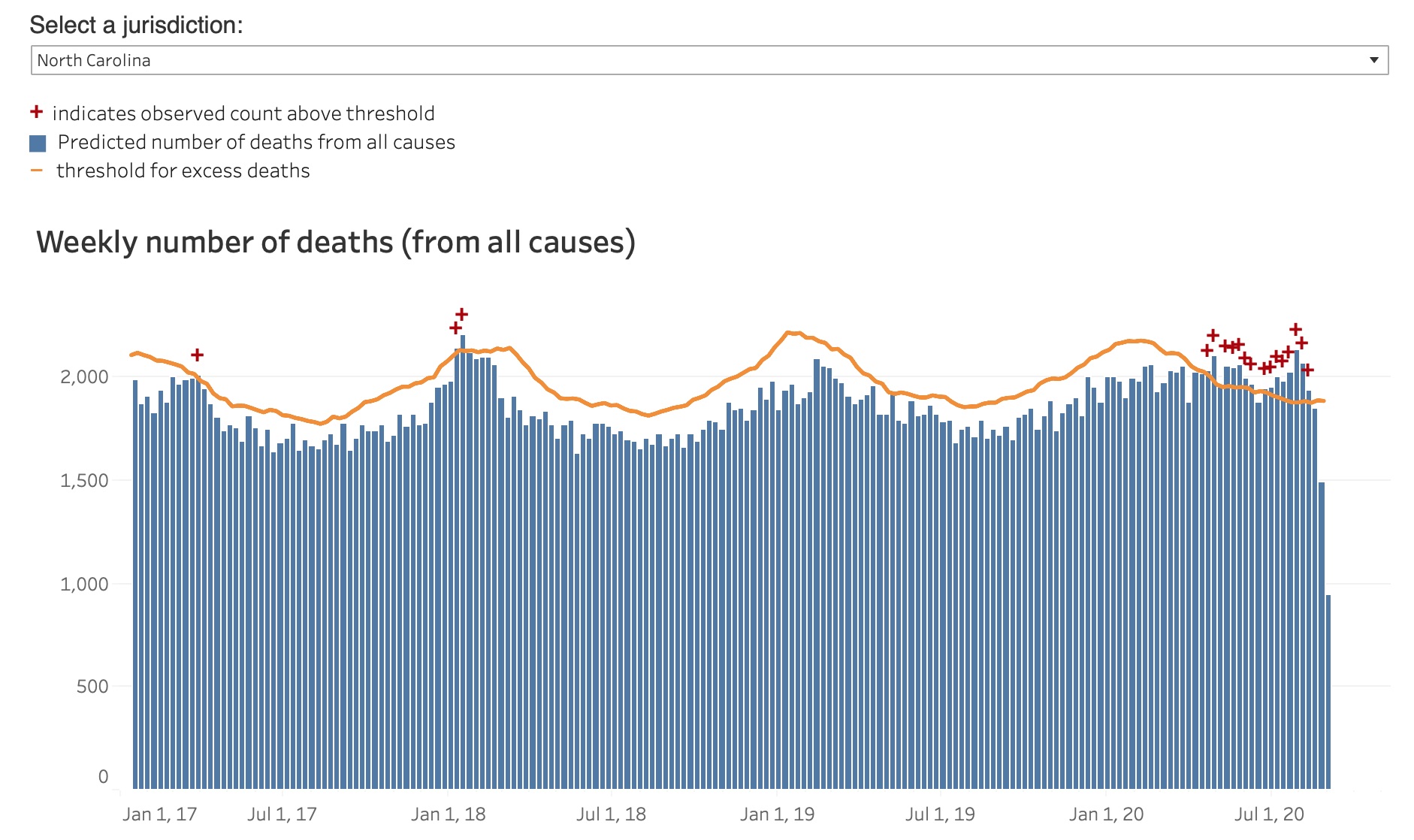Are Gov. Cooper’s lockdowns, business shutdowns and partial shutdowns, social-distancing policies, gathering bans, and myriad other restrictions on people, places, and events having devastating health effects on North Carolinians?
Put another way: Does the government “cure” rival the disease?
Over the past weeks and months, a growing chorus of scientists, public health experts, economists, and others have warned against the dangerous and indeed deadly consequences of government lockdowns, shutdowns, and other restrictions in trying to address COVID-19.
In October, the World Health Organization (WHO) made a sudden about-face on lockdowns and shutdowns. WHO had originally cautioned nations against reopening their economies too soon or too quickly, but now its policy is that such restrictions ought to be a policy of last resort. WHO cited significant harm, especially to the poor and children, from lockdowns and shutdowns.
Also in October, three of the world’s top health experts were joined by tens of thousands of medical professionals and scientists worldwide in signing the Great Barrington Declaration, warning: “As infectious disease epidemiologists and public health scientists we have grave concerns about the damaging physical and mental health impacts of the prevailing COVID-19 policies”:
Coming from both the left and right, and around the world, we have devoted our careers to protecting people. Current lockdown policies are producing devastating effects on short and long-term public health. The results (to name a few) include lower childhood vaccination rates, worsening cardiovascular disease outcomes, fewer cancer screenings and deteriorating mental health – leading to greater excess mortality in years to come, with the working class and younger members of society carrying the heaviest burden. Keeping students out of school is a grave injustice.
Over the summer, a very troubling survey from the Centers for Disease Control and Prevention (CDC) revealed severe impacts on people’s mental health from COVID-related lockdowns, social distancing policies, lives lost, illnesses, jobs lost, and financial insecurity. They ranged from increases in anxiety disorders, depressive disorders, substance abuse, to even suicide.
Shockingly, the CDC survey found that the worst effects were being felt by young adults (ages 18–24) and that over 25 percent of young adults said they had “seriously considered suicide in the past 30 days.”
Several studies of excess deaths under COVID-19 have estimated from 22 percent to 35 percent of excess deaths are not attributable to COVID-19, but instead to “indirect effects of the pandemic,” notably including lockdown policies, as well as social isolation, economic effects, and delayed or avoided medical care because of patient fears or hospital cancelations. Another study found inpatient admissions at the VA was down 42 percent for six potentially deadly ailments: stroke, myocardial infarction (MI), heart failure, chronic obstructive pulmonary disease, appendicitis, and pneumonia.
Excess deaths in NC from lockdowns and restrictions as well as COVID-19
Donald van der Vaart warned on Sept. 4 in Carolina Journal that “Excess deaths during COVID-19 likely include deaths owing to lockdowns and restrictions.” As van der Vaart explained, COVID-19 and governments’ responses to it, including in North Carolina, could be working at cross-purposes. The long-term negative health effects from lockdowns and shutdowns could even be deadlier overall than the pandemic.
“North Carolina may be witnessing an unusual number of deaths from other causes,” van der Vaart wrote, later adding, “All this might argue that the cure may be as bad or worse than the disease.”
Such concerns prompted me to write back on August 28 about the problem of the NC Department of Health and Human Services (DHHS) being last in the nation in reporting death data:
Thanks to DHHS, we don’t know if there are causes of excess deaths in North Carolina in July and August. I’m using the plural — causes — deliberately.
It’s becoming increasingly evident that there are other potential excess deaths events taking place beyond deaths owing COVID-19. … Worse, DHHS’s daily deaths reporting is also infamously dodgy. How can public health officials know if and what kind of health crises North Carolinians are facing — and be able to take action quickly in response — when our data reports are six weeks late?
DHHS is no longer six weeks late in reporting these data. Now the state bureaucracy headed by Mandy Cohen is eight weeks behind all but two other states. Whereas the rest of the nation has updated its data through October 24, DHHS is stuck on August 29, a day after I asked if we were missing other causes of excess deaths. (Connecticut has reported through October 3 and West Virginia through October 17.)
Nevertheless, by examining what data we do have from DHHS supplemented by the CDC’s estimates for the weekly average expected deaths from all causes in NC and the threshold for excess deaths, we can estimate whether deaths in NC from causes other than COVID-19 are also worse than expected.
Here is the CDC’s chart of weekly number of deaths from all causes in NC, going back to 2017. You can see where excess deaths are indicated — red plus signs above the columns that cross the orange line used to represent the threshold for excess deaths.

And here is a chart I have produced using CDC and DHHS data. I have broken North Carolina’s weekly death columns into non-COVID deaths (blue section) and deaths attributed by DHHS to COVID-19 (orange section) and graphed them against the CDC’s average weekly deaths number and the excess death threshold.

The results are sobering. Deaths either from or with COVID-19 don’t tell the whole story of weekly deaths in North Carolina. Something else is going on.
As you can see, starting in April, without accounting for COVID-19 deaths, the weekly deaths in North Carolina have been above average. The only two exceptions are the weeks ending May 2 and June 13.
Worse, for the weeks ending July 4, July 18, and July 25, North Carolina was suffering excess deaths without even counting COVID-19 deaths. Something else unusual was happening that was contributing to more North Carolinians dying than should be expected.
The problem may even be worse than that. As already discussed here, DHHS is doesn’t distinguish between deaths from COVID-19 (i.e., someone dying from COVID-induced pneumonia) and deaths with COVID-19 (i.e., someone dying from Stage 4 cancer who happened to test positive for COVID-19). This inflation of COVID-19 deaths means that several more weeks could actually reflect excess deaths from non-COVID causes. They would be the weeks ending April 25, May 9, May 16, May 23, July 11, and August 1.
Questions that need answering now — lives are at stake
Based on experts’ concerns, the CDC survey, WHO’s reversal on lockdowns, the Great Barrington Declaration, and the lack of an obvious alternate explanation, we need to ask the question that began this column: Are Gov. Cooper’s lockdowns, business shutdowns and partial shutdowns, social-distancing policies, gathering bans, and myriad other restrictions on people, places, and events having devastating health effects on North Carolinians?
What if they are? How would Cooper and Cohen know to heed the chorus of experts against lockdowns and shutdowns if their numbers are current only through mid-August? How many North Carolinians are suffering negative health impacts because of it?
In July, when North Carolina was suffering twin excess death events, the COVID numbers were at their peaks. In recent weeks those peaks have been rivaled. Are we suffering twin excess death events now?
If Cooper’s highly restrictive executive orders are once again exacerbating excess deaths in North Carolina while trying to fight COVID-19, his administration might not know about this grim failure for another two and a half months. Presumably they could take action now to stop it if they knew. But how many North Carolinians are suffering needlessly now in the meantime?


